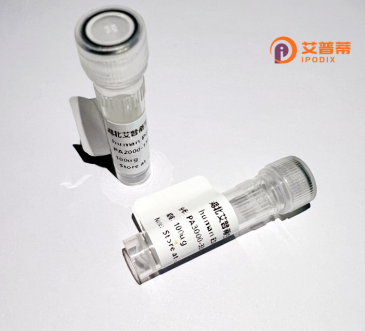
| 纯度 | >90%SDS-PAGE. |
| 种属 | Human |
| 靶点 | TGIF2 |
| Uniprot No | Q9GZN2 |
| 内毒素 | < 0.01EU/μg |
| 表达宿主 | E.coli |
| 表达区间 | 2-237 aa |
| 活性数据 | SDSDLGEDE GLLSLAGKRK RRGNLPKESV KILRDWLYLH RYNAYPSEQE KLSLSGQTNL SVLQICNWFI NARRRLLPDM LRKDGKDPNQ FTISRRGGKA SDVALPRGSS PSVLAVSVPA PTNVLSLSVC SMPLHSGQGE KPAAPFPRGE LESPKPLVTP GSTLTLLTRA EAGSPTGGLF NTPPPTPPEQ DKEDFSSFQL LVEVALQRAA EMELQKQQDP SLPLLHTPIP LVSENPQ |
| 分子量 | 25.8 kDa |
| 蛋白标签 | His tag N-Terminus |
| 缓冲液 | PBS, pH7.4, containing 0.01% SKL, 1mM DTT, 5% Trehalose and Proclin300. |
| 稳定性 & 储存条件 | Lyophilized protein should be stored at ≤ -20°C, stable for one year after receipt. Reconstituted protein solution can be stored at 2-8°C for 2-7 days. Aliquots of reconstituted samples are stable at ≤ -20°C for 3 months. |
| 复溶 | Always centrifuge tubes before opening.Do not mix by vortex or pipetting. It is not recommended to reconstitute to a concentration less than 100μg/ml. Dissolve the lyophilized protein in distilled water. Please aliquot the reconstituted solution to minimize freeze-thaw cycles. |
以下是关于重组人TGIF2(TGFB-Induced Factor Homeobox 2)蛋白的3篇代表性文献及其简要摘要:
1. **文献名称**:*TGIF2 interacts with histone deacetylases and represses Smad-mediated transcription*
**作者**:Wotton, D. et al.
**摘要**:研究揭示了TGIF2作为转录抑制因子,通过招募组蛋白去乙酰化酶(HDACs)形成复合物,抑制TGF-β/Smad信号通路驱动的基因表达。实验显示TGIF2可直接结合Smad蛋白,干扰其与DNA结合能力。
2. **文献名称**:*The role of TGIF2 in embryonic development and cellular differentiation*
**作者**:Melhuish, T.A. et al.
**摘要**:本文通过基因敲除模型分析,发现TGIF2在小鼠胚胎发育中调控神经管闭合和器官形成,其缺失导致严重发育缺陷,提示TGIF2通过调控靶基因表达维持细胞分化平衡。
3. **文献名称**:*TGIF2 promotes tumorigenesis by modulating redox homeostasis in hepatocellular carcinoma*
**作者**:Wang, Y. et al.
**摘要**:研究发现TGIF2在肝细胞癌中高表达,通过激活NOX4/ROS信号通路促进肿瘤细胞增殖和转移。重组TGIF2蛋白实验证实其调控氧化应激相关基因的功能,成为潜在治疗靶点。
以上文献涵盖TGIF2在分子机制、发育生物学及肿瘤学中的功能研究。如需具体年份或期刊信息,可进一步补充关键词检索调整。
Transforming growth factor-β-induced factor 2 (TGIF2), also known as THAP-like homeobox protein, is a transcriptional regulator involved in diverse cellular processes. It belongs to the TGIF protein family and contains a conserved THAP domain, a zinc-finger motif enabling DNA binding, and a homeobox domain critical for protein-protein interactions. TGIF2 primarily functions as a transcriptional repressor by recruiting chromatin-modifying complexes (e.g., histone deacetylases) to target genes, thereby suppressing gene expression.
Biologically, TGIF2 plays key roles in embryonic development, particularly in neural tube formation, axial patterning, and organogenesis. It interacts with signaling pathways like TGF-β, Wnt, and retinoic acid to regulate cell differentiation, apoptosis, and proliferation. Dysregulation of TGIF2 is associated with pathological conditions, including cancers (e.g., gastric, liver) where it often acts as an oncogene by promoting cell migration and epithelial-mesenchymal transition. Conversely, mutations in TGIF2 have been linked to holoprosencephaly (HPE), a congenital brain malformation disorder.
Recombinant human TGIF2 protein, produced via bacterial or mammalian expression systems, enables functional studies of its DNA-binding properties, protein interactions, and regulatory mechanisms. Its structural and functional characterization continues to inform therapeutic strategies targeting TGIF2-associated diseases.
×